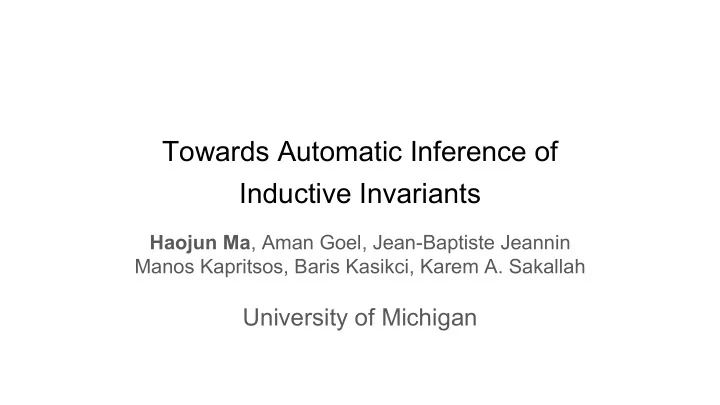

Towards Automatic Inference of Inductive Invariants Haojun Ma , Aman Goel, Jean-Baptiste Jeannin Manos Kapritsos, Baris Kasikci, Karem A. Sakallah University of Michigan
Distributed systems are subtle 1
The alternative: formal verification Formal specification or property Proving the system maintains the property Successful on distributed systems Drawback: Manual effort 2
Existing verification approaches Verdi(Coq) IronFleet(Dafny) Ivy I4 Manual Effort Person-years Person-months Person-hours Automated All existing approaches require the human to find an inductive invariant We want to automatically find inductive invariants 3
Formal verification in 2 minutes Goal: prove that the safety property holds at all times An execution: Initial . . . 0 1 2 k k+1 state Inductive proof Base case: prove initial state is safe ● Inductive step: if state k is safe, prove state k+1 is safe ● 4
Safety property vs. inductive invariant All states Inductive Reachable invariant states Safe states 5
Lock server protocol Client0 Server0 Safety property: no two clients can be linked to the same server Client1 Server1 Client2 6
Finding an inductive invariant using Ivy Automatically checks if an invariant is inductive (Screenshot from Ivy) Requires the human to find an inductive invariant Existing approaches rely on lock_hold manual effort and human intuition Safety property Strengthening assertion 7
Outline I4: a new approach Design of I4 Evaluation Future work 8
I4: a new approach Goal: Find an inductive invariant without relying on human intuition. Insight: Distributed protocols exhibit regularity . • Behavior doesn’t fundamentally change as the size increases • E.g. lock server, Paxos, … Implication: We can use inductive invariants from small instances to infer a generalized inductive invariant that holds for all instances. 9
Leveraging model checking Model checking J Fully automated L Doesn’t scale to distributed systems I4 applies model checking to small, finite instances … … and then generalizes the result to all instances. 10
Outline Design of I4 Evaluation Future work 11
Overview Invariant generation on Invariant Correct a finite instance generalization Protocol.ivy ✓ (Model Checking) (Ivy) Increase Size 12
Invariant generation on a finite instance Debug Counterexample (manually) Invariant Protocol.v Create Small Model Correct generalization Protocol.ivy ✓ (Finite) Instance Checker (Ivy) Protocol.finv Increase Size 13
Invariant Generalization Debug Strengthening Counterexample Weaken (manually) Assertion Violation Protocol.v Create Small Model Correct Protocol.ivy Protocol_inv.ivy Ivy ✓ (Finite) Instance Checker Safety Protocol.finv Generalize Property Violation Increase Size 14
Outline Evaluation Future work 15
Evaluation Lock Server Leader Election Distributed lock 1 server 3 nodes 2 nodes 2 clients 3 IDs 4 epochs ~3s ~8s ~12s ✓ ✓ ✓ 16
Outline Future work 17
Future work More automation Scalability to larger protocols Verification of Implementations 18
Recommend
More recommend